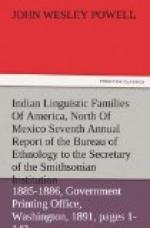The Conestoga, and perhaps some allied tribes, occupied the country about the Lower Susquehanna, in Pennsylvania and Maryland, and have commonly been regarded as an isolated body, but it seems probable that their territory was contiguous to that of the Five Nations on the north before the Delaware began their westward movement.
As the Cherokee were the principal tribe on the borders of the southern colonies and occupied the leading place in all the treaty negotiations, they came to be considered as the owners of a large territory to which they had no real claim. Their first sale, in 1721, embraced a tract in South Carolina, between the Congaree and the South Fork of the Edisto,[44] but about one-half of this tract, forming the present Lexington County, belonging to the Congaree.[45] In 1755 they sold a second tract above the first and extending across South Carolina from the Savannah to the Catawba (or Wateree),[46] but all of this tract east of Broad River belonged to other tribes. The lower part, between the Congaree and the Wateree, had been sold 20 years before, and in the upper part the Broad River was acknowledged as the western Catawba boundary.[48] In 1770 they sold a tract, principally in Virginia and West Virginia, bounded east by the Great Kanawha,[47] but the Iroquois claimed by conquest all of this tract northwest of the main ridge of the Alleghany and Cumberland Mountains, and extending at least to the Kentxicky River,[49] and two years previously they had made a treaty with Sir William Johnson by which they were recognized as the owners of all between Cumberland Mountains and the Ohio down to the Tennessee.[50] The Cumberland River basin was the only part of this tract to which the Cherokee had any real title, having driven out the former occupants, the Shawnee, about 1721.[51] The Cherokee had no villages north of the Tennessee (this probably includes the Holston as its upper part), and at a conference at Albany the Cherokee delegates presented to the Iroquois the skin of a deer, which they said belonged to the Iroquois, as the animal had been killed north of the Tennessee.[52] In 1805, 1806, and 1817 they sold several tracts, mainly in middle Tennessee, north of the Tennessee River and extending to the Cumberland River watershed, but this territory was claimed and had been occupied by the Chickasaw, and at one conference the Cherokee admitted their claim.[53] The adjacent tract in northern Alabama and Georgia, on the headwaters of the Coosa, was not permanently occupied by the Cherokee until they began to move westward, about 1770.
[Footnote 44: Cession No. 1, on Royce’s Cherokee map, 1884.]
[Footnote 45: Howe in
Schoolcraft, Ind. Tribes, 1854, vol. 4,
p. 163.]
[Footnote 46: Cession 2, on Royce’s Cherokee map, 1884.]
[Footnote 47: Howe in
Schoolcraft, Ind. Tribes, 1854, vol. 4, pp.
155-159.]
[Footnote 48: Cession 4, on Royce’s Cherokee map, 1884.]




